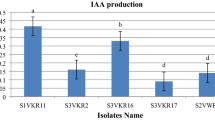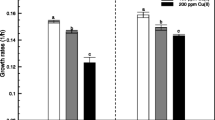Abstract
Mesorhizobium strain RC3, isolated from chickpea nodules, tolerated chromium up to 500 μg/ml and reduced it by 90% at pH 7 after 120 h. It produced plant growth-promoting substances, both in the presence and absence of chromium. Strain RC3 produced 35 μg indole acetic acid/ml in Luria Bertani broth with 100 mg tryptophan/ml, which decreased with an increase in chromium concentration. Chromium application to soil at 136 mg/kg was toxic to chickpea plants but when RC3 at 136 mg/kg was also added, it increased the dry matter accumulation, number of nodules, seed yield and grain protein by 71, 86, 36 and 16%, respectively, compared to non-inoculated plants. Nitrogen in roots and shoots were increased by 46 and 40%, respectively, at 136 mg Cr/kg. The bio-inoculant decreased the uptake of chromium by 14, 34 and 29% in roots, shoots and grains, respectively.



Similar content being viewed by others
References
Alexander DB, Zuberer DA (1991) Use of chrome azurol S reagents to evaluate siderophore production by rhizosphere bacteria. Biol Fertil Soils 12:39–45
Brick JM, Bostock RM, Silversone SE (1991) Rapid in situ assay for indole acetic acid production by bacteria immobilized on nitrocellulose membrane. Appl Environ Microbiol 57:535–538
Eaton AD, Clesceri LS, Greenberg AE (eds) (1992) Standard methods for the examination of water and wastewater. American Public Health Association; American Water Works Association (AWWA), Water Environment Federation (WEF), Washington DC, 981
Holt JG, Krieg NR, Sneath PHA, Staley JT, Willams ST (eds) (1994) Bergey’s manual of determinative bacteriology. Williams & Wilkins, Baltimore, USA
McLean J, Beveridge TJ (2001) Chromate reduction by Pseudomonad isolated from a site contaminated with chromated copper arsenate. Appl Environ Microbiol 67:1076–1084
McLean J, Beveridge TJ, Phipps D (2000) Isolation and characterization of a chromium reducing bacterium from a chromated copper arsenate contaminated site. Environ Microbiol 2:611–619
Ortegel JW, Staren ED, Faber LP, Warren WH, Braun DP (2002) Modulation of tumor-infiltrating lymphocyte cytolytic activity against human non-small cell lung cancer. Lung cancer 36:17–25
Ouzounidou GE, Eleftheriou P, Karataglis S (1992) Ecophysiological and ultrastructural effects of copper in Thlaspi ochroleucum (cruciferae). Can J Bot 70:947–957
Reeves MW, Pine L, Neilands JB, Balows A (1983) Absence of siderophore activity in Legionella species grown in iron-deficient media. J Bacteriol 154:324–329
Wani PA, Khan MS, Zaidi A (2007) Cadmium, chromium and copper in greengram plants. Agron Sustain Dev 27:145–153
Wani PA, Khan MS, Zaidi A (2007) Chromium reduction, plant growth promoting potentials and metal solubilization by Bacillus sp. isolated from alluvial soil. Curr Microbiol 54:237–243
Zayad A, Terry N (2003) Chromium in the environment: factors affecting biological remediation. Plant Soil 249:139–156
Author information
Authors and Affiliations
Corresponding author
Rights and permissions
About this article
Cite this article
Wani, P.A., Khan, M.S. & Zaidi, A. Chromium-reducing and plant growth-promoting Mesorhizobium improves chickpea growth in chromium-amended soil. Biotechnol Lett 30, 159–163 (2008). https://doi.org/10.1007/s10529-007-9515-2
Received:
Revised:
Accepted:
Published:
Issue Date:
DOI: https://doi.org/10.1007/s10529-007-9515-2




